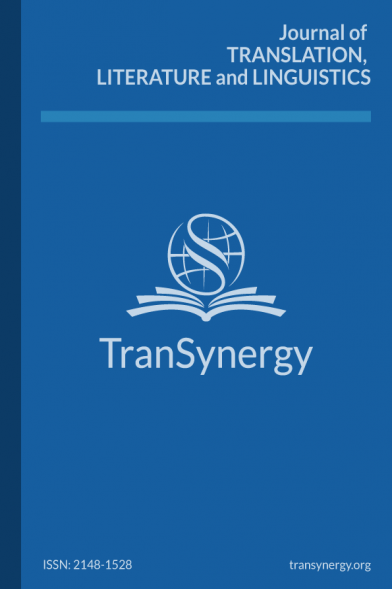Training on Simultaneous Interpreting at Undergraduate Level in Türkiye: Analysis of Resources
Simultaneous interpreting, university, undergraduate training, interpreteracademicians, laboratory
Training on Simultaneous Interpreting at Undergraduate Level in Türkiye: Analysis of Resources
Simultaneous interpreting, university, undergraduate training, interpreteracademicians, laboratory,
___
Abbasbeyli, E. (2020). The role of dragomans in the Ottoman Empire. International Association of Conference Interpreters. Retrieved on November 7, 2022, from https://aiic.org/document/937/AIICWebzine_2014_Issue65_4_ABBASBEYLI_The_ Role_of_Dragomans_in_the_Ottoman_Empire_EN.pdf
AICC (2019). History of the profession. International Association of Conference Interpreters. Retrieved on September 30, 2022, from https://aiic.org/site/world/about/history/profession
AICC (2022). History of AICC. International Association of Conference Interpreters. Retrieved on November 7, 2022, from https://aiic.org/site/world/about/history
Ak, E., D. Akbulut, F., Erguvan, M. (2021). Sözlü çeviri kabin ortamının ögrencilerin sözlü çeviri performansina etkisi. Social Sciences Research Journal, 10(1), 8-16.
Amelina, S.M., & Tarasenko, R.O. (2020). Using modern simultaneous interpretation tools in the training of interpreters at universities. ICTERI 2020: Kharkiv, Ukraine (pp. 188- 201).
Arslan Özcan, L. (2019). Türkiye’de konferans çevirmenliğinin doğuşu ve gelişimi. Türkiye Konferans Tercümanları Derneği. Retrieved on November 8, 2022 from https://www.tktd.org/tarihce/
Diriker, E. (Ed.). (2018). Türkiye’de sözlü çeviri: Eğitim, uygulama ve araştırmalar. Scala Yayıncılık.
Encyclopedia Britannica (2022). Nürnberg Trials – World War II Trials. Retrieved on November 7, 2022, from https://www.britannica.com/event/Nurnberg-trials
Erdoğdu, Ş., & Tosun, M. (2021). İstanbul Üniversitesinin kuruluş yıllarında Alman profesörlerin derslerinde yapılan ilk sözlü çeviri denemeleri (1933-1953). Turkish Studies - Language and Literature, 16(3), 2053-2064. https://doi.org/10.7827/TurkishStudies.51985
Flerov, C. (2020). On Comintern and Hush-a-Phone: Early history of simultaneous interpretation equipment. International Association of Conference Interpreters (AICC). Retrieved on September 30, 2022, from https://aiic.org/document/893/AIICWebzine_2013_Issue63_5_FLEROV_On_Comi ntern_and_Hush-aPhone_Early_history_of_simultaneous_interpretation_equipment_EN.pdf
Gaiba, F. (1998). The origins of simultaneous interpretation: The Nuremberg Trial. University of Ottawa Press.
Guise, K. (2020). Translating and interpreting the Nuremberg Trials. The National WWII Museums. Retrieved on November 7, 2022, from https://www.nationalww2museum.org/war/articles/translating-and-interpretingnuremberg-trials
Lim, L. (2015). Moving from the language lab to the interpreting booth: Student perceptions. Translation and Cross-Cultural Communication Studies in the Asia Pacific, 42, 351- 368.
Pan, J. (2016). Linking classroom exercises to real-life practice: A case of situated simultaneous interpreting learning. The Interpreter and Translator Trainer, 10(1), 107-132. https://doi.org/10.1080/1750399X.2016.1154346
Pöchhacker, F. (2018). Moving boundaries in interpreting. In H. V. Dam, M. N. Brøgger, & K. K. Zethsen (Eds.), Moving boundaries in translation studies (1st ed.) (pp. 45-63). Routledge. https://doi.org/10.4324/9781315121871-4
Şahin, M., Eraslan, Ş. (2017). Sözlü çeviri eğitiminde yeni yaklaşımlar: Sanal dünyalar. In N. Kansu Yetkiner & M. Şahin (Eds.), Dilbilim Çeviribilim yazıları (pp. 193-206). Anı Yayıncılık.
Visson, L. (2005). Simultaneous interpretation: Language and cultural difference. In S. Bermann & M. Wood (Eds.), Nation, language, and the ethics of translation, (pp. 51– 64). Princeton University Press
Vural Kara, S. (2010). Tarihsel değerlendirmeler ışığında Türkiye’de çeviri etkinliği. Mersin Üniversitesi Eğitim Fakültesi Dergisi, 6(1), 94-101.
Yagi, S. M. (2000). Language labs and translation booths: Simultaneous interpretation as a learner task. Language, Culture and Curriculum, 13(2), 154-173. https://doi.org/10.1080/07908310008666596
YÖK Atlas (2022). Mütercim ve Tercümanlık Bölümü bulunan tüm üniversiteler. Yükseköğretim Kurulu. Retrieved on October 18, 2022, from https://yokatlas.yok.gov.tr/lisans-bolum.php?b=97174
- ISSN: 2979-9503
- Yayın Aralığı: Yılda 2 Sayı
- Başlangıç: 19.12.2022
V.S. NAIPAUL’S A HOUSE FOR MR. BISWAS: A STUDY OF LIMINALITY
From Colonial to Postcolonial: Dissemination of the English Language
Ursula Le Guin as a Feminist Self-Translator
Betül Hazal DİNÇER, Sinem SANCAKTAROĞLU BOZKURT
The Impact of Discourse Markers on Conversational Coherence
Training on Simultaneous Interpreting at Undergraduate Level in Türkiye: Analysis of Resources
